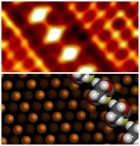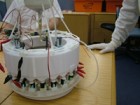
Tuesday July 20, 2010
Daily edition
News and Blog Headlines
Autism has unique vocal signature, new technology reveals
Polymer synthesis could aid future electronics
Artificial gut frees sewage-eating robot from humans
Top Secret America
Reprogrammed Stem Cells Remember Their Past
Artificial cells communicate and cooperate like biological cells, ants
H+ Magazine relaunches, published by Humanity+
Latest News
Autism has unique vocal signature, new technology reveals
July 20, 2010
Polymer synthesis could aid future electronics
LENA (Language Environment Analysis), a new automated vocal analysis technology, could fundamentally change the study of language development as well as the screening for autism spectrum disorders and language delay, reports a study in the July 19 online Proceedings of the National Academy of Sciences.
The LENA (Language Environment Analysis) system automatically labeled infant and child vocalizations from recordings and thereafter an automatic acoustic analysis designed by the researchers showed that pre-verbal vocalizations of very young children with autism are distinctly different from those of typically developing children with 86 percent accuracy.
The most important of these parameters proved to be the ones targeting syllabification, the ability of children to produce well-formed syllables with rapid movements of the jaw and tongue during vocalization. The autistic sample showed little evidence… more
July 20, 2010
Artificial gut frees sewage-eating robot from humans
In a paper published in the Proceedings of the National Academy of Sciences, a team of researchers from Canada and the Department of Energy's Oak Ridge National Laboratory. and two Canadian universities outlined their success in growing highly structured short chains of polymer poly(3,4-ethylenedioxythiophene), or PEDOT.
Synthesis of a conjugated organic polymer–widely used as a conductive material in devices like light-emitting diodes, televisions and solar cells–could mean more efficient, cheaper electronics. Because of its role as conductive material in organic light-emitting diodes, PEDOT is found in many electronic devices such as televisions and computer monitors, as well as many solar panel cells.
Improving and controlling the molecular order of a nanostructured PEDOT material is critical to the polymer's performance in… more
July 20, 2010 Source Link: New Scientist Tech
Top Secret America
The Bristol Robotics Lab in the UK has developed the self-sustaining Ecobot III robot. It has an artificial gut and digestive tract, allowing it can survive for up to seven days, feeding and "watering" itself unaided.
It uses a recycling system that relies on a gravity-fed peristaltic pump which, like the human colon, applies waves of pressure to squeeze unwanted matter out of a tube.
The robot feeds a nutrient-rich solution of partially processed sewage pumped into its "mouth," where it is distributed into 48 separate microbial fuel cells (MFCs) — bio-electrochemical devices that enlist cultures of bacteria to break down food to generate power.This fluid is a concoction of minerals, salts, yeast extracts and other nutrients.
July 20, 2010
Reprogrammed Stem Cells Remember Their Past
The Washington Post has released its interactive "Top Secret America" website, describing the huge national security buildup in the United States after the Sept. 11, 2001 attacks.
The series of articles and an online database at topsecretamerica.com depict the scope and complexity of the government's national security program through interactive maps and other graphics. More than a dozen Washington Post journalists spent two years developing the database and website.
July 20, 2010 Source Link: Technology Review
Artificial cells communicate and cooperate like biological cells, ants
July 20, 2010
H+ Magazine relaunches, published by Humanity+
Inspired by the social interactions of ants and slime molds, University of Pittsburgh engineers have designed computational models of artificial cells capable of self-organizing into independent groups that can communicate and cooperate to transport chemicals and drugs.
The Pitt group's microcapsules interact by secreting nanoparticles in a way similar to how biological cells signal to communicate and assemble into groups. And with a nod to ants, the cells leave chemical trails as they travel, prompting fellow microcapsules to follow. The "signaling" cell secretes nanoparticles known as agonists that prompt the second "target" microcapsule to emit nanoparticles known as antagonists.
As the signaling cell (right) emits the agonist nanoparticles (blue), the target cell (left) responds with antagonists (red) that stop the first cell from secreting. Once the… more
July 20, 2010
H+ Magazine will relaunch Tuesday July 20, now published by the nonprofit organization Humanity+ (formerly the World Transhumanist Association), KurzweilAI.net has learned.
H+ Magazine, which covers technological, social and cultural trends that change humans in fundamental ways, began publishing in 2008, and went on hiatus June 1. R.U. Sirius, a.k.a. Ken Goffman, will remain as the magazine's editor.
"It's very exciting to be able to continue working on this publication that covers so many extraordinary and exciting potentials and possibilities for our species at this critical moment in human history," he said. "We look forward to expanding into various formats that will emerge during the coming months and years. And you can bet that in addition to informing and enlightening, we intend to keep our… more
New Events
Biomass '10: Renewable Power, Fuels, and Chemicals Workshop
Dates: Jul 20 — 21, 2010
Location: Grand Forks, North Dakota
more...2010 IEEE Conference on Innovative Technologies for an Efficient and Reliable Electricity Supply
Dates: Sep 27 — 29, 2010
Location: Waltham, Massachusetts
more...World Energy Engineering Conference
Dates: Dec 8 — 10, 2010
Location: Washington, D.C.
more...IEEE Energy Conference and Exhibition
Dates: Dec 18 — 22, 2010
Location: Manama, Bahrain
more...International Joint Conference on Advances in Engineering and Technology
Dates: Dec 20 — 23, 2010
Location: Trivandrum, India
more...
martes, 20 de julio de 2010
KurzweilAI.net Daily Newsletter
Suscribirse a:
Enviar comentarios (Atom)





No hay comentarios:
Publicar un comentario